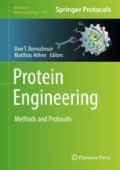Abstract
In biocatalysis, structural knowledge regarding an enzyme and its substrate interactions complements and guides experimental investigations. Structural knowledge regarding an enzyme or a biocatalytic reaction system can be generated through computational techniques, such as homology- or molecular modeling. For this type of computational work, a computer program developed for molecular modeling of proteins is required. Here, we describe the use of the program YASARA Structure. Protocols for two specific biocatalytic applications, including both homology modeling and molecular modeling such as energy minimization, molecular docking simulations and molecular dynamics simulations, are shown. The applications are chosen to give realistic examples showing how structural knowledge through homology and molecular modeling is used to guide biocatalytic investigations and protein engineering studies.
References
Faber K (2011) Biotransformations in organic chemistry: a textbook, 6th edn. Springer, Heidelberg
Luetz S, Giver L, Lalonde J (2008) Engineered enzymes for chemical production. Biotechnol Bioeng 101:647–653
Widmann M, Pleiss J, Samland AK (2012) Computational tools for rational protein engineering of aldolases. Comput Struct Biotechnol J 2:e201209016
Chen R (2001) Enzyme engineering: rational redesign versus directed evolution. Trends Biotechnol 19:13–15
Chica RA, Doucet N, Pelletier JN (2005) Semi-rational approaches to engineering enzyme activity: combining the benefits of directed evolution and rational redesign. Curr Opin Biotechnol 16:378–384
Turner NJ (2009) Directed evolution drives the next generation of biocatalysts. Nat Chem Biol 5:567–573
Otten LG, Hollmann F, Arends IWCE (2009) Enzyme engineering for enantioselectivity: from trial-and-error to rational design? Trends Biotechnol 28:46–54
Lutz S (2010) Beyond directed evolution - semi-rational protein engineering and design. Curr Opin Biotechnol 6:734–743
Bommarius AS, Blum JK, Abrahamson MJ (2011) Status of protein engineering for biocatalysts: how to design an industrially useful biocatalyst. Curr Opin Chem Biol 15:194–200
Bornscheuer UT, Huisman GW, Kazlauskas RJ et al (2012) Engineering the third wave of biocatalysis. Nature 485:185–194
Steiner K, Schwab H (2012) Recent advances in rational approaches for enzyme engineering. Comput Struct Biotechnol J 2:e201209010
The Protein Data Bank http://www.rcsb.org/pdb/home/home.do
Bergman HM, Henrick K, Nakamura H (2003) Announcing the world-wide Protein Data Bank. Nat Struct Biol 10:980
Epstain CJ, Goldberger RF, Anfinsen CB (1963) The genetic control of tertiary protein structure: studies with model systems. Cold Spring Harb Symp Quant Biol 28:439–449
Epstain CJ (1964) Relation of protein evolution to tertiary structure. Nature 203:1350–1352
Chothia C, Lesk AM (1986) The relation between the divergence of sequence and structure in proteins. EMBO J 5:823–836
Sander C, Schneider R (1991) Database of homology-derived protein structures and the structural meaning of sequence alignment. Proteins 9:56–68
Rost B (1999) Twilight zone of protein sequence alignments. Protein Eng 12:85–94
Krieger E, Nabuurs SB, Vriend G (2003) Homology modeling. In: Bourne PE, Weissig H (eds) Structural bioinformatics. John Wiley & Sons, Hoboken, NJ
Tramontano A (2006) Protein structure prediction. Concepts and applications. Wiley-VCH, Weinheim
Venselaar H, Joosten RP, Vroling B et al (2010) Homology modeling and spectroscopy, a never ending love story. Eur Biophys J 39:551–563
Leach AR (2001) Molecular modelling – principles and applications, 2nd edn. Dorset Press, Dorchester
Information regarding the YASARA program products www.yasara.org/products.html
Krieger E, Vriend G (2014) YASARA View - molecular graphics for all devices - from smartphones to workstations. Bioinformatics 30:2981–2982
The NCBI GenBank: www.ncbi.nlm.nih.gov
Benson DA, Cavanaugh M, Clark K et al (2013) GeneBank. Nucleic Acids Res 41:D36–D42
Pre-made script in YASARA for homology modeling simulations http://www.yasara.org/hm_build.mcr
Altschul SF, Madden TL, Schäffer AA et al (1997) Gapped BLAST and PSI-BLAST: a new generation of protein database search programs. Nucleic Acids Res 25:3389–3402
Hooft RW, Vriend G, Sander C et al (1996) Errors in protein structures. Nature 381:272
Jones DT (1999) Protein secondary structure prediction based on position-specific scoring matrices. J Mol Biol 292:195–202
Konagurthu AS, Whisstock JC, Stuckey PJ et al (2006) MUSTANG: a multiple structural alignment algorithm. Proteins 64:559–574
Denesyuk AI, Denessiouk KA, Korpela T et al (2002) Functional attributes of the phosphate group binding cup of pyridoxal phosphate-dependent enzymes. J Mol Biol 316:155–172
Sayer C, Isupov MN, Westlake A et al (2013) Structural studies with Pseudomonas and Chromobacterium [omega]-aminotransferases provide insights into their differing substrate specificity. Acta Crystallogr Sect D 69:564–576
Baugh L, Phan I, Begley DW et al (2015) Increasing the structural coverage of tuberculosis drug targets. Tuberculosis 95:142–148
Silverman RB (2002) The organic chemistry of enzyme-catalysed reactions, 2nd edn. Academic Press, London, pp 388–390
Pre-made script in YASARA written by Elmar Krieger for molecular docking simulations http://www.yasara.org/dock_run.mcr
Pre-made script in YASARA written by Elmar Krieger to visualize (play up) a molecular docking simulation http://www.yasara.org/dock_play.mcr
Svedendahl M, Branneby C, Lindberg L et al (2010) Reversed enantiopreference of an ω-transaminase by a single-point mutation. ChemCatChem 2:976–980
Svedendahl Humble M, Engelmark Cassimjee K, Abedi V et al (2012) Key amino acid residues for reversed or improved enantiospecificity of an ω-transaminase. ChemCatChem 4:1167–1172
Steffen-Munsberg F, Vickers C, Thontowi A et al (2013) Connecting unexplored protein crystal structures to enzymatic function. ChemCatChem 5:150–153
Steffen-Munsberg F, Vickers C, Thontowi A et al (2013) Revealing the structural basis of promiscuous amine transaminase activity. ChemCatChem 5:154–157
Pre-made script in YASARA written by Elmar Krieger for molecular dynamics simulation http://www.yasara.org/md_run.mcr
Pre-made script in YASARA written by Elmar Krieger to visualize (play up) a molecular dynamics simulation http://www.yasara.org/md_play.mcr
Acknowledgment
This work was funded by KTH Royal Institute of Technology.
Author information
Authors and Affiliations
Corresponding author
Editor information
Editors and Affiliations
Rights and permissions
Copyright information
© 2018 Springer Science+Business Media LLC
About this protocol
Cite this protocol
Land, H., Humble, M.S. (2018). YASARA: A Tool to Obtain Structural Guidance in Biocatalytic Investigations. In: Bornscheuer, U., Höhne, M. (eds) Protein Engineering. Methods in Molecular Biology, vol 1685. Humana Press, New York, NY. https://doi.org/10.1007/978-1-4939-7366-8_4
Download citation
DOI: https://doi.org/10.1007/978-1-4939-7366-8_4
Published:
Publisher Name: Humana Press, New York, NY
Print ISBN: 978-1-4939-7364-4
Online ISBN: 978-1-4939-7366-8
eBook Packages: Springer Protocols

